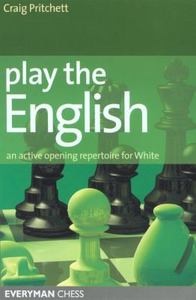Play The English
Craig Pritchett

Scottish IM Craig Pritchett made his name as an author almost three decades ago when he wrote opening books on the Scheveningen Sicilian and the Nimzo-Indian. Had he written nothing more he would be remembered for the excellence of these two works which examined opening theory through well chosen and carefully annotated games. Recently he has broken new ground with Play The English.
Like his previous works Play The English is arranged around model games in this case 30 of them. Pritchett advocates a center-oriented approach to the English. This means White aims for d4 when possible and doesnt automatically fianchetto his King Bishop. In this respect and many others, Play The English differs markedly from GM Tony Kostens The Dynamic English which favors 1.c4 and 2.g3. Kostens book, which is less main line oriented, offers a more or less complete opening repertoire. You will not get that with Pritchetts book. For the Kings Indian, Dutch and Queens Gambit family of openings you need to look elsewhere. I would say as practical measure at least 300 pages if not more would be needed for a comprehensive mainline 1.c4 repertoire book.
Play The English covers lines arising from the English, primarily 1.c4 e5 and 1.c4 c5. As far as I know it is the only current book on 1.c4 e5. Pritchett covers all lines from Whites perspective from this sequence, including the Four Knights (1.c4 e5 2.Nc3 Nf6 3.Nc3 Nc6 4.g3 Bb4), Reversed Sicilians with …d5, the early …Bb4 on move two and attempts to get a Closed Sicilian Reverse (he likes 1.c4 e5 2.Nc3 Nc6 3.Nf3 meeting 3…f5 with 4.d4).
The repertoire in the Symmetrical English consists of aiming for d4. This means 1.c4 c5 2.Nf3 Nf6 3.Nc3 Nc6 4.d4, 2…Nc6 3.d4 and 2…Nf6 3.Nc3 d5 4.cxd5 Nxd5 5.d4. You will not find coverage of the Maroczy Bind, which is important as it often arises from the Symmetrical English. Pritchett likes 6.a3 in the mainline (1.c4 c5 2.Nf3 Nf6 3.Nc3 Nc6 4.d4 cxd4 5.Nxd4 e6) and does a good job describing how to deal with Blacks attempts to get into a type of Hedgehog structure. In all the lines mentioned above he presents readers with a clear course of action. That isnt the case with the Hedgehog proper (1.c4 c5 2.Nf3 Nf6 3.Nc3 e6 4.g3 b6 5.Bg2 Bb7) where he gives one game with Re1 followed by e4 and only then d4, and another with the immediate d4 and Bg5. Both lines are perfectly playable but much different in their aims.
Pritchett, in offering two alternatives, gives readers a choice, but at the cost of more comprehensive coverage of one of them. For example it would have been interesting to learn more about the sequence 1.c4 c5 2.Nf3 Nf6 3.Nc3 e6 4.g3 b6 5.Bg2 Bb7 6.0-0 Be7 7.d4 cxd4 8.Qxd4 d6 9.Bg5 a6 10.Qd2 (Pritchett concentrates on 10.Bxf6 in my opinion he is little optimistic about Whites chances for obtaining an advantage) 10…Nbd7 11.Qd2 0-0 12.Bf4 Ne8 13.Rac1 Qc7 14.b3 Rc8. Black looks like he has been driven back, but many games have shown the resiliency of his position to attempts to further pressure d6, play for e4-e5 or expand on the kingside with g4. Pritchett gives one example without annotations of the slightly weird looking 15.Qe3. The few tests with the Queen move, which aims for a well-timed Nd5, have been promising and appear to offer White some hope of getting an advantage against one of the toughest nuts to crack in the Symmetrical English. One way of looking at this is that Pritchett is writing Play The English on different levels for different readers and for those who are familiar with the line he offers a little morsel to point them in the right direction.
The final chapter is on English-Indians. The anti-Grunfeld weapon advocated may be a little dry to some tastes 1.c4 Nf6 2.Nc3 g6 3. Nf3 d5 4.cxd5 Nxd5 5.Qa4+ Bd7 6.Qh4 Nxc3 7.dxc3 Nc6 8.e4 e5 9.Bg5 Be7 10.Bc4 but Pritchett believes it offers White a slight but pleasant plus with the first player aiming for two results. There is some discussion of the wild 4.g4 after 1.c4 Nf6 2.Nc3 e6 3.Nf3 Bb4 (there is nothing on 3…b6) but preference is given to 4.g3 in the model games.
Play The English is a book that will be useful for players of a variety of strengths. Pritchett writes well and is good at explaining the various plans for both sides. The lines he advocates are likely to hold up for a long time there is no ultra sharp quick knockout stuff that can be refuted by a single sharp move. Though the title is Play The English, those who open with 1.Nf3 and 2.c4 will find much of it useful.
I recommend this book with the one caveat that the reader be aware that this book needs to be supplemented with material on the Kings Indian, Dutch, Queen’s Gambit (including Slav and Semi-Slav) and Maroczy Bind for a complete repertoire.
